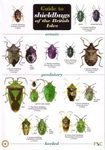![Armored Scale Insects: Their Biology, Natural Enemies and Control, Part B Armored Scale Insects: Their Biology, Natural Enemies and Control, Part B]()
Click to have a closer look
About this book
Related titles
About this book
Part B of the 2 volume work on armored scale insects.
2. THE NATURAL ENEMIES.
Entomopathogenic fungi
(H.G. Evans, C. Prior).
Predators.
Coccinellidae (J.J. Drea, R.D. Gordon). Other coleoptera (J.J. Drea). Neuroptera (J.J. Drea). Cecidomyiidae and other diptera (K.M. Harris). Thysanoptera (J.M. Palmer, L.A. Mound). Acari (U. Gerson et al).
Ectoparasites
(D. Rosen, P. DeBach).
Endoparasites.
Aphelinidae (G. Viggiani). Encyrtidae (J.S. Noyes). Signiphoridae (J.B. Woolley).
Hyperparasites
(G. Viggiani).
Ecology and efficacy of natural enemies.
Natural enemies and prey population regulation (C.B. Huffaker, A.P. Gutierrez). The attributes of effective natural enemies (C.B. Huffaker, D. Rosen). Effects of environmental factors on natural enemies of armored scale insects (C.B. Huffaker). Host resistance: Encapsulation of parasites (D. Blumberg).
Techniques.
Sampling for natural enemies (M. Rose). Preparation for scientific study: Coleoptera and neuroptera (J.J. Drea); Cecidomyiidae (K.M. Harris); Thysanoptera (J.M. Palmer, L.A. Mound); Mites (B.M. O'Conner, M.A. Houck); Chalcid parasitoids (J.S. Noyes). Rearing and mass rearing of natural enemies (M. Rose). Analysis of the gut contents of predators (Z. Mendel et al). Toxicological test methods (A. Havron, D. Rosen).
3. DAMAGE AND CONTROL.
Armored scale insects as pests.
A list of the armored scale insect pests (D.R. Miller, J.A. Davidson). Economic importance (M. Kosztarab).
Quarantine problems and procedures
(H.C. Burger, S.A. Ulenberg).
Eradication
(R.J. Gill).
Forecasting and monitoring infestations.
Forecasting (F. Kozr). Sampling and census-taking (F. Kozr). Use of pheromone traps (M.J. Gieselmann, R.E. Rice). Remote sensing as a tool to detect factors influencing armored scale insect populations (W.G. Hart). Economic thresholds (L.J. Moffitt, J.L. Baritelle).
Chemical control.
Control chemicals (L.A. Riehl). Insect growth regulators (B. Darvas, L. Varjas). Chemical control of males (N. Angerilli).
Biological control.
Introduction (D. Rosen). Foreign Exploration and importation of natural enemies (M. Rose, P. DeBach). Augmentation of natural enemies: Periodic colonization (M. Rose); Genetic improvement of natural enemies of armored scale insects (M.A. Hoy); Potential for semiochemical manipulation of beneficial insects against scale insects (S.B. Vinson). Conservation of natural enemies (M. Rose, P. DeBach). Evaluation of efficiency of natural enemies in biological control (C.B. Huffaker, A.P. Gutierrez). Case histories (D. Rosen).
Mechanical control: High-pressure rinsing of fruit
(E.C.G. Bedford).
Integrated pest management.
IPM: Background and general methodology (D. Rosen). A case history: IPM on citrus in israel (Y. R#ssler, D. Rosen). The systems approach to integrated pest management, with emphasis on the armored scale insects (G.C. Brown, D.A. Potter).
Diaspidid pest problems andcontrol in crops.
Citrus (M. Rose). Other tropical fruit trees and shrubs (T.H. Chua, B.J. Wood). Tea (S. Nagarkatti, T. Sankaran). Sugar cane (J.R. Williams, D.J. Greathead). Olive (L.C. Argyriou). Date palm (C. Benassy). Deciduous fruit trees (F. Kozr). Ornamental plants (J.A. Davidson, D.R. Miller). Forests (J. Zahradnk): Conifers; Other forests. Bamboo (Y. Ben-Dov).
Customer Reviews






















![Hémiptères de France, de Belgique, du Luxembourg et de Suisse [Hemiptera of France, Belgium, Luxembourg and Switzerland]](http://mediacdn.nhbs.com/jackets/jackets_resizer_medium/22/226274.jpg?height=150&width=106)
![Tentōmushi: Getcho Sensei no Tentoumushikorekushon [Ladybirds: Mr. Getcho's Ladybird Collection]](http://mediacdn.nhbs.com/jackets/jackets_resizer_medium/26/264269.jpg?height=150&width=108)











